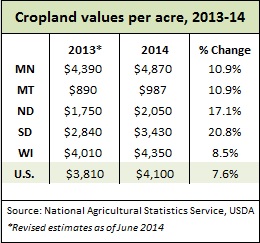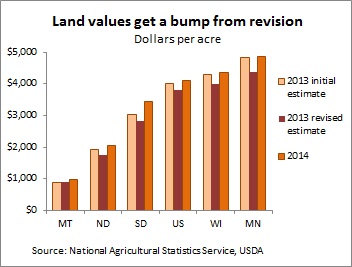In early August, the USDA released its annual estimates of farmland values, showing an increase of 7.6 percent for U.S. cropland in 2014 over a year earlier. Values in the district were up even more; South Dakota saw the biggest increase in the country at 20.8 percent (see table). This was something of a surprise, given results from the Minneapolis Fed’s second-quarter survey of agricultural credit conditions, which indicate that farmland price growth has slowed and even decreased in some cases.

One reason for the discrepancy is obvious—the numbers come from different surveys. The Fed survey covers lenders, while the USDA’s covers landowners themselves and is also much larger and more thorough. But another reason USDA land values showed a bigger jump this year goes back to June, when earlier USDA estimates of 2009-13 land values were revised. In most states, earlier values were revised down, which makes the increase in 2014 look bigger than it otherwise would have.
For example, the USDA estimated that Minnesota cropland sold for $4,850 an acre when it released its summary in August 2013. Last June, it revised that estimate down to $4,050 an acre, 9.5 percent less than the earlier estimate. The newly released 2014 Minnesota estimate of $4,870 is nearly unchanged from the earlier 2013 number, so much of the apparent jump this year reflects a downward revision of last year’s statistics (see chart).
Given the larger sample size and rigorous methodology, the USDA survey is a better indicator than the Fed’s. But the revisions suggest that land prices may not have grown as much in 2013 and earlier years as initially thought.

Joe Mahon is a Minneapolis Fed regional outreach director. Joe’s primary responsibilities involve tracking several sectors of the Ninth District economy, including agriculture, manufacturing, energy, and mining.





